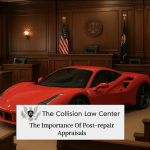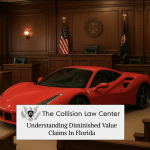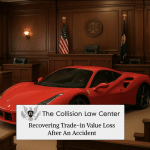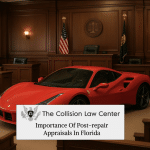Experiencing a car accident can be a traumatic event, and coping with the aftermath is often overwhelming. One of the most challenging aspects is gathering the necessary evidence for a diminished value claim. In many cases, evidence document collection car accident procedures require careful attention to detail and prompt actions to preserve key documentation. Victims may feel lost when trying to secure photos, police reports, repair estimates, and other critical pieces of evidence to support their claim. You may also be concerned with the financial implications of decreased vehicle value despite repairs. It is important to understand that the road to a fair settlement starts with effective evidence collection. This introductory article aims to provide clear guidance and empathetic support to help you navigate this process with confidence. We will discuss essential steps, share practical examples, and explain why precise evidence collection is indispensable to a successful diminished value claim. Whether you are facing insurance challenges or legal hurdles, remembering to document every detail can make a crucial difference to your case. As you read on, you will learn how to organize documentation and why gathering the right evidence is a key step toward reclaiming the value lost in a car accident.
Background What Evidence Document Collection in Car Accidents Entails
Collecting evidence in the aftermath of a car accident means assembling all documents that support your claim of diminished vehicle value. This collection often includes photographs of damages, comprehensive police reports, repair estimates, and even communication logs with your insurer or repair shop. The process is not automated and demands a personal, meticulous approach. For example, if your car suffered extensive body damage and the subsequent repairs were not completely reflective of its original condition, having a detailed visual record and repair invoices is essential. Another example would be a vehicle that, although repaired to operational status, lost market appeal because of persistent cosmetic issues; documented proof of such issues serves as critical evidence when filing your diminished value claim. The clarity, accuracy, and timeliness of collecting these documents directly affect the strength of your case. Without sufficient documentation, the claim might be undervalued or even denied. It is crucial to understand each document’s role in establishing both the initial severity of damage and its long-term impact on the vehicle’s resale value.
Why Evidence Document Collection Car Accident Matters
Having proper evidence for your diminished value claim is important because it creates a solid foundation for your case. In the aftermath of a car accident, insurance companies often examine the available documents to determine the reduced worth of your vehicle. Poor evidence or missing documents can significantly lower the potential claim amount. Comprehensive documentation is not just an administrative step; it also helps protect your rights as a victim by offering a clear narrative of the accident and its consequences. By preparing timely and accurate reports, you reassure adjusters and legal professionals that you are well-informed and serious about asserting your rights.
The real-world impact of proper evidence collection translates into financial relief and a smoother claims process. Insurers are more likely to provide fair settlements when the documentation is robust. Otherwise, you may end up with a settlement that barely covers the decreased market value of your vehicle. This situation could leave you with a considerable financial gap, which is why obtaining accurate evidence is crucial. The correct documents serve as the backbone of your claim and can ultimately determine whether you secure full compensation for your losses.
- Scenario 1 and consequence 1: Incomplete documentation may lead insurers to undervalue your claim, resulting in inadequate compensation.
- Scenario 2 and consequence 2: Delays in collecting evidence can weaken the claim, potentially causing a denial of your diminished value compensation.
- Scenario 3 and consequence 3: Failure to document specific damages accurately may leave you with ongoing financial and legal burdens.
How Evidence Document Collection Operates in the Miami Fort Lauderdale Region
- Step 1: Immediately after the accident, secure all relevant documents and take clear photographs of all damages, ensuring that every angle is documented.
- Step 2: Contact local authorities to obtain the official police report. This document plays a crucial role in verifying your accident details and establishing liability.
- Step 3: Reach out to repair shops and request detailed estimates along with any records of work performed. These documents underline the extent of the damage and repairs needed.
Expert Advice for Managing Your Evidence Document Collection Car Accident Claims
Common Questions Regarding Evidence Document Collection in the Miami Fort Lauderdale Area
How The Collision Law Center Provides Support to Car Accident Victims
The Collision Law Center has a long-established reputation for supporting car accident victims through every step of the legal process. Their team of experienced attorneys takes the time to understand the difficulties that survivors face after an accident. They offer personalized advice that is both compassionate and practical. With a focus on evidence document collection car accident claims, the center helps clients organize their documentation to enhance their claim strength. Their deep understanding of local laws in the Miami Fort Lauderdale region allows them to deliver precise, tailored legal strategies. Clients benefit from dedicated representation that strives to secure fair settlements while minimizing the stress involved in litigation. By offering clear communication and steadfast support, The Collision Law Center guides clients toward a secure future and helps restore a sense of peace during challenging times.
In a Nutshell Insights on Evidence Document Collection Car Accident
In summary, effectively managing your evidence document collection following a car accident is key to a successful diminished value claim. The process involves prompt documentation, obtaining detailed records, and taking all steps necessary to build a compelling case. Understanding local protocols and expert advice can significantly influence the outcome.
In conclusion, collecting thorough evidence after a car accident is fundamental to protecting your rights and securing fair compensation. From immediate photographic documentation and official police reports to detailed repair estimates, every piece of evidence plays a critical role in substantiating your diminished value claim. The guidance provided in this article underscores the importance of being methodical, proactive, and informed. The emotional toll of an accident can be significant, yet with careful preparation and the right legal support, you can navigate the claims process more effectively. Remember that informed decisions and accurate documentation can transform a challenging situation into a manageable legal pursuit. With the practical tips and expert advice discussed, victims can step forward with confidence knowing that every effort to preserve the facts contributes to a solid, defensible case. Taking these steps not only clarifies your position but can also lead to financial recovery and peace of mind after a car accident.










